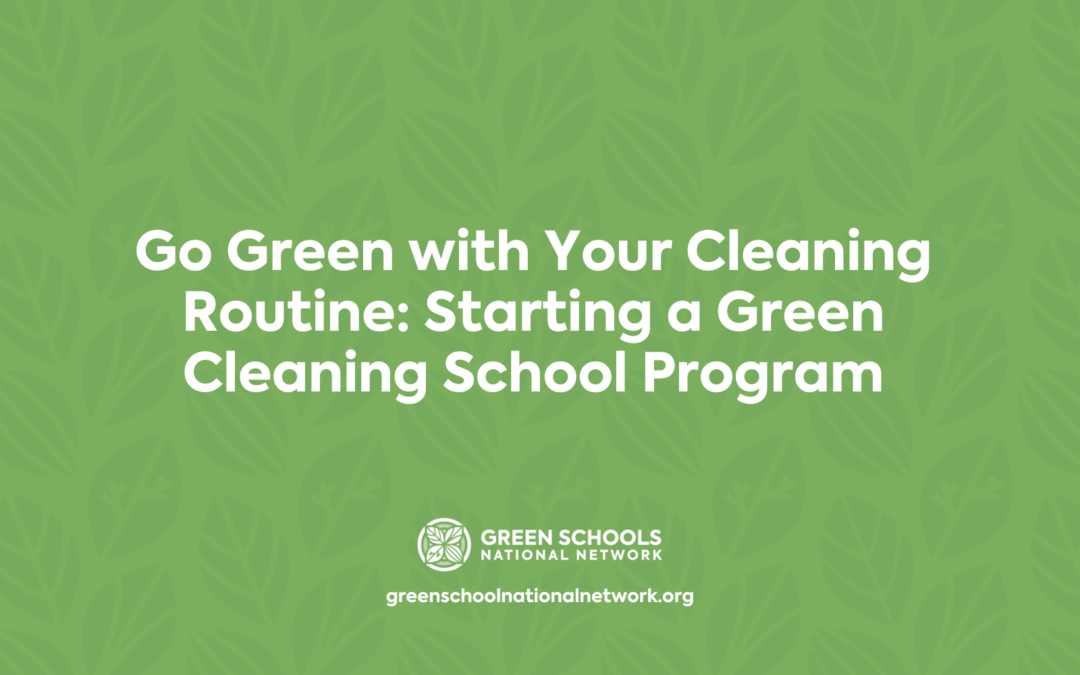A healthy school environment is key to supporting the well-being and academic performance of all students. Keeping schools clean and safe is essential to maintaining such an environment, especially as schools return to in-person learning. However, many conventional cleaning products contain potentially harmful chemicals that can negatively affect indoor air quality and lead to health problems for students and adults, including asthma and other respiratory illnesses, headaches, nausea, and skin irritation. Greening your cleaning routine can be a simple and cost-effective solution to keeping your school clean and healthy.
What is Green Cleaning?
Green cleaning programs employ products and practices that are safer and healthier for people and the planet. Green cleaning products typically have one or more of the following attributes:
- Low or no volatile organic compounds
- No known carcinogens
- No ozone depleting compounds
- Neutral pH levels
Use renewable resources and/or natural materials
Green cleaning practices seek to minimize the amount of cleaning products used while keeping those using the products safe. Examples of some of these practices include:
- Keeping chemical safety data sheets in an accessible location.
- Purchasing products as concentrates and diluting on-site.
- Reading and following product labels.
- Using microfiber cleaning cloths and other tools to minimize the amount of product used.
- Spraying cleaning cloths with product rather than the surface when cleaning.
- Storing cleaning products based on their properties (not alphabetically).
Cleaning the school building when it’s unoccupied.
The Benefits of Going Green
There are numerous benefits to adopting a green cleaning program at your school. First and foremost, green cleaning programs protect students, who are more sensitive to chemicals than adults, and custodial staff, who frequently interact with cleaning products. By keeping those who spend time in school buildings safe and healthy, green cleaning programs can lead to fewer student, teacher, and staff absences. They can increase the lifespan of school facilities and improve the school environment by reducing pollutants such as pesticides, molds, and other toxins that can lead to poor indoor air quality and negative health outcomes. They can also increase cost savings for schools through the purchase and use of fewer cleaning products.
Five Steps to Kickstarting a Green Cleaning Program
Ready to bring a green cleaning program to your school? Be sure to keep these five things in mind as you get your program up and running.
Evaluate your current cleaning practices. Before making the switch, it’s important to understand your school’s basic cleaning needs and how you currently address them. This will help you identify how and where to modify your cleaning practices and use of cleaning products.
Establish a green cleaning plan for your school. This plan should include policies and procedures that cover training, clean practices, purchasing, storage, and disposal. Everyone in the school community has a role to play in maintaining a clean and healthy learning environment, so be sure to involve teachers, administrators, purchasing officials, custodians, parents, and student in designing and implementing the plan.
Select cleaning products with positive environmental attributes. In addition to choosing products with the attributes listed above, look for products that are biodegradable, use less packaging, and have third-party certifications, like Green Seal and the U.S. Environmental Protection Agency’s Safer Choice. When purchasing neutral cleaners, glass cleaners, bathroom cleaners, and disinfectants, consider products that have high dilution rates, are designed to reduce waste, and have lower end-use costs. Avoid cleaning products that contain fragrances that might trigger asthma symptoms, or those with strong odors. Most importantly, involve facilities and custodial staff in the selection and testing of cleaning products – after all, they will be the ones using the products.
Practice responsible chemical management. The following tips will help you get started:
- Assess your storage practices. Are products clearly labeled, in undamaged containers, organized according to compatible chemical families, and stored on appropriate shelving?
- Conduct an annual inventory of your cleaning products. Identify and properly dispose of products that are outdated, unknown, or not needed.
Reduce bulk purchasing. Many schools buy more cleaning products than they need. Consider your cleaning needs for the school year and only buy the quantity of product you will need. - Maintain a standardized list of approved and disapproved cleaning products. Such a list will ensure all custodial staff use the same cleaning products and
- techniques and discourage the practice of bringing in cleaning products from home.
Provide opportunities for training and education. Training and education for custodial staff is crucial for successful implementation and sustainability of a green cleaning program. Topics covered should include:
- The attributes and health benefits of green cleaning products.
- Proper use of green cleaning products, including how to read and follow labels for storage, use, and disposal.
- Cleaning practices and policies, including appropriate procedures for handling a chemical spill.
Green cleaning is one of the practices highlighted in our GreenPrint. Download the GreenPrint and discover more best practices for healthy, equitable, and sustainable facilities and operations.

